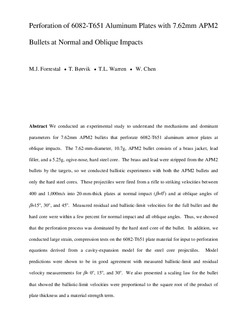Perforation of 6082-T651 Aluminum Plates with 7.62 mm APM2 Bullets at Normal and Oblique Impacts
Journal article, Peer reviewed
Accepted version
Permanent lenke
http://hdl.handle.net/11250/2464937Utgivelsesdato
2014Metadata
Vis full innførselSamlinger
Sammendrag
We conducted an experimental study to understand the mechanisms and dominant parameters for 7.62 mm APM2 bullets that perforate 6082-T651 aluminum armor plates at oblique impacts. The 7.62-mm-diameter, 10.7 g, APM2 bullet consists of a brass jacket, lead filler, and a 5.25 g, ogive-nose, hard steel core. The brass and lead were stripped from the APM2 bullets by the targets, so we conducted ballistic experiments with both the APM2 bullets and only the hard steel cores. These projectiles were fired from a rifle to striking velocities between 400 and 1,000 m/s into 20-mm-thick plates at normal impact (β = 0o) and at oblique angles of β = 15o, 30o, and 45o. Measured residual and ballistic-limit velocities for the full bullet and the hard core were within a few percent for normal impact and all oblique angles. Thus, we showed that the perforation process was dominated by the hard steel core of the bullet. In addition, we conducted large strain, compression tests on the 6082-T651 plate material for input to perforation equations derived from a cavity-expansion model for the steel core projectiles. Model predictions were shown to be in good agreement with measured ballistic-limit and residual velocity measurements for β = 0o, 15o, and 30o. We also presented a scaling law for the bullet that showed the ballistic-limit velocities were proportional to the square root of the product of plate thickness and a material strength term.
